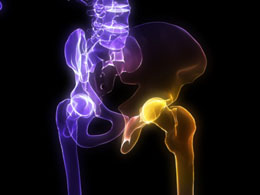Treatment for bone spurs in hip is aimed at relieving the pain and preventing stiffness and inflammation of the joint. Read this article to enrich your knowledge on various options of treatment that are available for hip bone spurs.

The medical name for bone spurs is osteophytes. It can be described as a bony projection that grows over a normal bone. They are mostly found at the edges of the bones in various body joints that include the hip joint. Bone spurs in the hip is a sign of degeneration of the hip joint structure. Even though the size of a bone spur is quite small, it exerts a lot of pressure on the nerves and bone in the nearby area. As a result, the patient experiences a sharp pain in the hip joint particularly during its movements. The pain often leads to inflammation of the hip joint and it becomes stiff. As a result, rotating and flexing of the hip muscles for walking becomes a painful affair and one starts limping.
What Causes Bone Spurs in Hip?
Osteoarthritis affecting the hip joint is one of the main causes that triggers growth of bone spurs in this region. This form of arthritis is characterized by degeneration of the soft cartilage tissues present in the hip joint. Basically, the cartilage provides protection to the bones at the joint and prevents them from getting rubbed against during hip movement. As it wears out, the bones get rubbed against each other and suffer damage due to the friction. The body makes an attempt to repair this damage in the bone with the help of a bony growth, which we call bone spur. If the hip joint is damaged during a traumatic injury, then the body tries to heal it and a bone spur is formed during the process. Calcium build up in the tendons and ligament of the hip joint is another cause.
Treatment
When you visit your doctor with hip joint pain, they conduct a physical examination first. The problem is mainly diagnosed with the help of X-rays. It is often followed by a MRI scan and CT scan. The treatment for hip bone spurs depends on the condition of the patient. Usually, patients with mild symptoms are treated with conservative methods of treatment. All patients with this condition are advised to take adequate amount of rest. This is because the hip joint bears the entire body weight when you are standing and walking. Resting prevents any further irritation in the hip joint. Nonsteroidal anti-inflammatory drugs are prescribed for pain reduction. If there are signs of muscle spasms, then muscle relaxants are also given to the patients. These medicines are combined with nutritional supplements like glucosamine as it facilitates pain relief. When the pain is severe, these oral medicines may not be enough and doctors administer cortisone shots directly into the affected hip joint. Apart from that, the stiffness of the hip joint can be reduced to some extent with physical therapy.
Severe bone spurs that limit the hip's motion and badly interferes with the daily activities of the patient, may require surgical treatment. This option is availed when no other treatment works for the patient. Doctors mostly consider hip replacement surgery or hip arthroplasty. In this procedure, the entire impaired hip joint is replaced with a prosthetic device. This device is designed in such a way that it is readily accepted by the body in which it has been used. There is another surgical method named osteotomy used for the treatment of hip spurs. In this procedure, a new hip joint socket is created with the healthy part of the bone and then the hip bone is fitted into it and is held by metal pins. Later on, once it heals up, the pins are removed. A surgery is followed by a rehabilitation program, which involves physical therapy. Here the physical therapist works upon the patients to add strength and flexibility to the hip joint, so that they can walk all over again.
Treatment for bone spurs in hip should never be delayed as it often leads to unnecessary complications. In fact, surgery can be avoided if the problem is diagnosed at an early stage. In a mild condition, doctors gives various helpful suggestions to the patient to minimize the pressure on the hip joint and thus, prevent any further degeneration of the joint.


 The medical name for bone spurs is osteophytes. It can be described as a bony projection that grows over a normal bone. They are mostly found at the edges of the bones in various body joints that include the hip joint. Bone spurs in the hip is a sign of degeneration of the hip joint structure. Even though the size of a bone spur is quite small, it exerts a lot of pressure on the nerves and bone in the nearby area. As a result, the patient experiences a sharp pain in the hip joint particularly during its movements. The pain often leads to inflammation of the hip joint and it becomes stiff. As a result, rotating and flexing of the hip muscles for walking becomes a painful affair and one starts limping.
The medical name for bone spurs is osteophytes. It can be described as a bony projection that grows over a normal bone. They are mostly found at the edges of the bones in various body joints that include the hip joint. Bone spurs in the hip is a sign of degeneration of the hip joint structure. Even though the size of a bone spur is quite small, it exerts a lot of pressure on the nerves and bone in the nearby area. As a result, the patient experiences a sharp pain in the hip joint particularly during its movements. The pain often leads to inflammation of the hip joint and it becomes stiff. As a result, rotating and flexing of the hip muscles for walking becomes a painful affair and one starts limping.